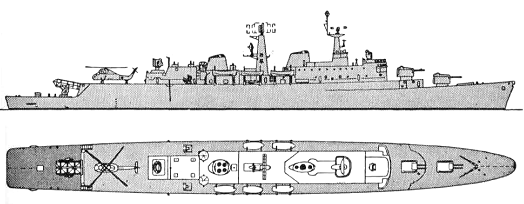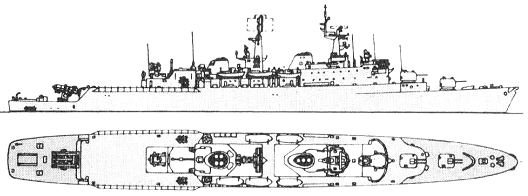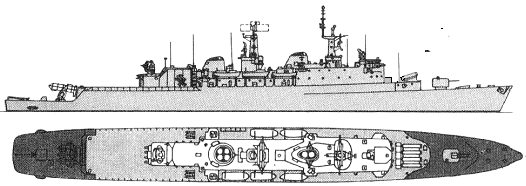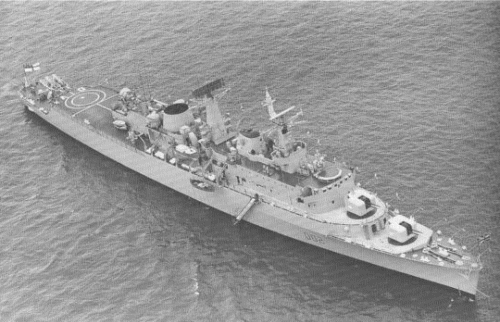

Kent 1965

Devonshire 1965

Glamorgan 1976

Devonshire 1979

Antrim 1979
| Name | No | Yard No | Builder | Laid down | Launched | Comp | Fate |
| Devonshire | D02 | Cammell Laird, Birkenhead | 9.3.1959 | 10.6.1960 | 15.11.1962 | sunk as target 17.7.1984 | |
| Hampshire | D06 | John Brown, Clydebank | 26.3.1959 | 16.3.1961 | 15.3.1963 | for BU 4.1979 | |
| London | D16 | Swan Hunter, Wallsend | 26.2.1960 | 7.12.1961 | 14.11.1963 | to Pakistan 3.1982 (بابر [Babur]) | |
| Kent | D12 | Harland & Wolff, Belfast | 1.3.1960 | 27.9.1961 | 15.8.1963 | training hulk 4.1980 | |
| Fife | D20 | Fairfield, Govan | 31.5.1962 | 9.7.1964 | 21.6.1966 | to Chile 8.1987 (Almirante Blanco Encalada) | |
| Glamorgan | D19 | Vickers-Armstrong, Tyne | 13.9.1962 | 9.7.1964 | 13.10.1966 | to Chile 9.1986 (Almirante Latorre) | |
| Antrim | D18 | Fairfield, Govan | 20.1.1966 | 10.10.1967 | 14.7.1970 | to Chile 6.1984 (Almirante Cochrane) | |
| Norfolk | D21 | Swan Hunter, Tyne | 15.3.1966 | 16.11.1967 | 7.3.1970 | to Chile 4.1982 (Capitán Prat) |
|
Displacement standard, t |
5440 |
|
Displacement full, t |
6800 |
|
Length, m |
153.9 pp 158.9 oa |
|
Breadth, m |
16.4 |
|
Draught, m |
6.20 max |
|
No of shafts |
2 |
|
Machinery |
COSAG: 2 sets AEI geared steam turbines, 2 Babcock & Wilcox boilers + 4 G6 gas turbines |
|
Power, h. p. |
30000+30000=60000 |
|
Max speed, kts |
32.5 |
|
Fuel, t |
oil + gas turbine oil 600 |
| Endurance, nm(kts) | 3500(28) |
|
Armament |
D02, 06, 16: 1 x 2 Sea Slug SAM (36), 2 x 4 Sea Cat GWS21 SAM (8), 2 x 2 - 120/45 Mk 6, 2 x 1 - 20/70 Mk 7, 1 helicopter (Wessex) D12: 1 x 2 Sea Slug SAM (36), 2 x 4 Sea Cat GWS22 SAM (8), 2 x 2 - 120/45 Mk 6, 2 x 1 - 20/70 Mk 7, 1 helicopter (Wessex) D18 - 21: 1 x 2 Sea Slug Mk 2 SAM (36), 2 x 4 Sea Cat GWS22 SAM (8), 2 x 2 - 120/45 Mk 6, 2 x 1 - 20/70 Mk 7, 1 helicopter (Wessex) |
|
Electronic equipment |
D02, 06, 16: type 978, type 965 AKE-1, type 277/278, type 992/993, type 901, type 903 radars, type 162M, type 184M sonars, UA-8/9 ECM suite, 2x Corvus decoy RL D12: type 978, type 965 AKE-1, type 277/278, type 992/993, type 901, type 903, 2x type 904 radars, type 162M, type 184M sonars, UA-8/9 ECM suite, 2x Corvus decoy RL D18 - 21: type 978, type 965 AKE-2, type 277/278, type 992Q/993, type 901, type 903, 2x type 904 radars, type 162M, type 184M sonars, UA-8/9 ECM suite, 2x Corvus decoy RL, ADAWS-1 CCS |
|
Complement |
440 - 471 |
Project history: The term 'destroyer' was applied to these ships to obtain Treasury approval, but they were later rated as DLGs, from the American term 'Destroyer Leader, Guided Missile', applied to the new generation of big fleet escorts. As in the USN ships, however, destroyer principles governed their design: there was no longitudinal subdivision and the ships had relatively light scantlings to keep down size and weight.
Like the Whitbys the design was volume-critical, and in particular it centered on the Seaslug missile system. Seaslug was a first-generation beam-rider, with its four booster-motors wrapped around the body. British guided weapons of the period relied on wrap-around boosters because it was feared (incorrectly) that end-on mounting of the booster would produce instability in the missile after launch.
Thus although the new DLG had ample vertical space between decks for upright stowage and loading through deck-hatches, she had to be given a horizontal 'tunnel' through the superstructure. The missiles are brought up from the forward magazine on a hoist and then travel through the tunnel, undergoing checkouts, fitting of wings, etc, before being run out on to the launcher. This was a somewhat over-engineered, massive lattice-work affair weighing as much as a gun turret. Although the figure of thirty-six rounds is quoted, it is believed to be less in view of their bulk.
Four ships were voted under the 1955-56 and 1956-57 Estimates, followed by another four under the 1961-622 and 1964-65 Estimates. The second group had the slightly unproved Seaslug Mk 2, externally identical, but having some capability against surface targets. They were also fitted with the 'double bedstead' AKE-2 version of the Type 965 long-range radar and had GWS22 directors controlling the Seacat missiles in place of GWS21. For the first time in a British warship, the design included provision for a medium helicopter, but arrangements for housing the Wessex - a hangar with a folding vertical door on the port side of the superstructure - were rather cumbersome.
The 'Counties' were, together with the 'Tribals', the first ships to have Combined Steam and Gas turbine (COSAG) machinery; main drive was supplied by twin HP and LP steam turbines and twin gas turbines are geared to the same shafts for boost. The system has the advantage of permitting the ship to get under way at short notice, as well as providing more power at high speed without excessive weight.
Modernizations: 1974, Norfolk; 1975, Antrim, Glamorgan, Fife: - 1 x 2 - 120/45, type 992/993 radar; + 4 x 1 Exocet MM38 SSM (4), type 992Q/993 radar
1974-75, Devonshire, Hampshire, London: - 2 x 4 Sea Cat GWS21 SAM (8); + 2 x 4 Sea Cat GWS22 SAM, 2x type 904 radars
1980s, all survived: + 4x Mk 36 SRBOC decoy RL
1984, Glamorgan: - helicopter (deckhouse on the helicopter deck)
1985, Fife: - 1 x 2 Sea Slug SAM
Naval service: Antrim was damaged by unexploded 1000pdr bomb from Argentine Dagger 21.5.1982. Glamorgan was badly damaged by unexploded Argentine Exoset launched from coastal launcher 12.6.1982.

Devonshire 1977
© Ivan Gogin, 2015